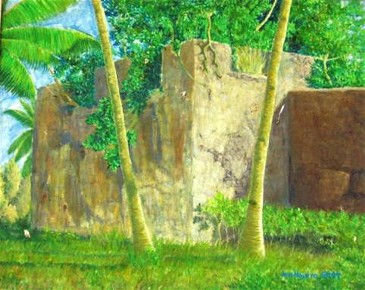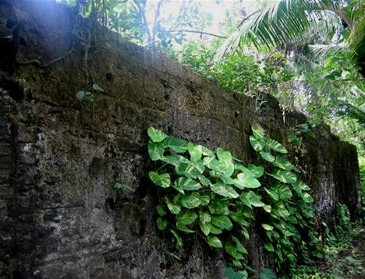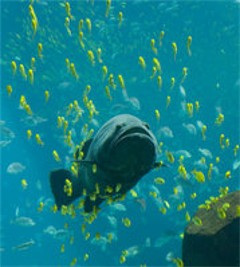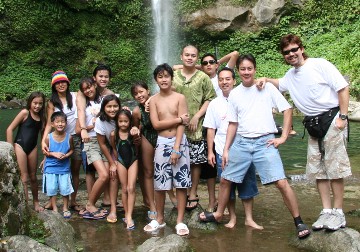KOTA sa OGTONG
By Ian Estuart
May 5, 2008
Last February 23 – 25 long weekend, my four daughters and I, together with Gil and Mara Maningo with their kids went up north to the beautiful and peaceful island of Bantayan.
We took off from Cebu city at 8:30AM, stopping for take-out lechon, puso and sunlutan kinilaw at Lilo-an. We made a 2 hour leisurely drive to Hagnaya wharf, then a one hour ferry ride across the northern tip of Tanon Strait, where the Lilo-an food was devoured with gusto. Then the blue skies, white sandy beaches and friendly islanders made such a warm welcome at Santa Fe, Bantayan Island.
Santa Fe is a modern name, the town used to be called Ogtong, named after a giant grouper the size of a bantam car. Rey Hubahib, amiable owner of Kota Beach resort where we stayed, says an Ogtong can outlive modern man and live to 80 up to 100 years old. Kadtong 100 years old nuon, basin bungi ug bungul na. Maybe it’s the cholesterol-free diet; lots of swimming exercise and absence of work-related stress that makes the fish live longer. Their smaller cousins, the Pugapo and Lapu-lapu are easier to catch and end up in sweet and sour dishes, but not the Ogtong, since it can bite the head off a fisherman before he can shout “Inun-unan!”
The morning after we arrived, a fellow neighbor from Santo Nino Village in Banilad, Scotsman Derek Thompson, excitedly led us to a painting of a fort at Kota Beach’s dining area. His enthusiasm on the painting was contagious. The resort is actually named after this fort. Derek narrated that back in Scotland, ruins of century-old structures attract tourists even when there’s not much left except cracked stones and vines. There is an open field where a big battle between the Scots and the English took place centuries ago (not Braveheart’s battle kuno), it’s just an open field with banners, yet tourists come in droves to marvel at the stories of what had happened in the empty open field. Sell the sizzle, not the steak.
Derek then led Gil and I to where the actual fort is, just 200 meters away. As soon as the three of us entered the ruins, we felt transported back in time. Isolated, tranquil and hidden by foliage, the place is captivating. I wandered away from my companions and started clicking away with my camera; I entered inside the turret wall that is depicted in the painting. After two clicks with my camera, a low psssst! called my attention, which triggered me to scamper into Gil and Derek’s direction with goose bumps. “There’s a presence there that doesn’t want me to take pictures!” I exhaled to them. So, there we were asking permission to allow us to take some more pictures and declaring we mean no harm and we are just visiting the place.
The fort or kota, is actually a convent, which housed the priests in the old Ogtong days. Since there were still no cement bags for sale at the hardware, I surmised that they used what the Spaniards did to construct the Baclayon church in Bohol, the oldest stone church in the country. They gathered the nearby stones and corals from the sea, and then they make it stick together using egg whites and a mixture of lime and sand. The egg yolks end up as native delicacy. That the stones and corals still stick together to this day is proof that egg whites are effective in binding them together forever like Simon and Garfunkel.
Many stories about this fort abound with the locals. It’s up to you to decide which is true. Although anecdotal, here’s what I gathered from Manang Portia Giducos, a friendly lady whose family live near the fort; in the old days pirates would avoid this fort because they see a mysterious child pacing the walls at night, many believe it’s the Senyor Santo Nino Himself making the appearances to protect the Ogtong dwellers from the marauders. Further, little footprints exist along the walls as proof of this, but I decided not to go back to look for the footprints as one pssst! is enough for the day.
In 1997, someone ordered the cutting of a Talisay tree inside the fort, the cutter himself was unharmed since he asked permission, but the one who ordered the cutting supposedly went through seizures afterwards. When you go to a Bisrock concert, you will have an idea how this seizure looks like.
In August of 2005, the original image of the Santo Nino in the nearby Santa Fe church was stolen! Whatever gain the perpetrators had of this unthinkable crime only their distorted minds can fathom. What followed after were relentless big waves that lasted for a month.
Today the ruins of the old fort still exist waiting for a move to convert it into a bustling museum. We know Bantayan Island offers white sand beaches, danggit and has peace-loving people. There are opportunities buried in ruins and captured in the memories of local folks that make our islands interesting for tourists to come and bring their friends along. Check it out yourself and please ask permission before taking pictures.
Photos provided by Ian Stuart & Gil Maningo
Related Article:
Photo Gallery
From left to right; Dianne E, Pancho M, Mara M, Tricia E, Jake M, Blessie E, Jannine E, Adrienne E, Vince M, Paolo M, Kenneth E, Phael Yangco, Ian E & Gil M.





